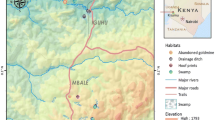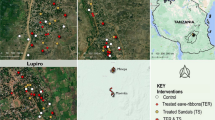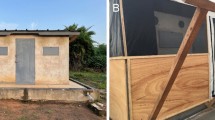Abstract
Fundamentally, larviciding with pyriproxyfen (PPF) has potential to complement Long Lasting Insecticide Nets (LLINs) and indoor residual sprays (IRS) in settings where resistance to pyrethroids and residual malaria transmission exist. In this study, we evaluated the field effectiveness of larviciding using PPF to reduce dry season productivity of mosquito breeding habitats that were located by pastoralists within the study area. Using pastoralist knowledge, dry season breeding habitats in Mofu village rural Tanzania were located and monitored for larval productivity for a period of 8 months before PPF intervention. During the intervention, six out of twelve breeding habitats were treated with Sumilarv 0.5G PPF granules. The impact of deposited PPF was monitored by recording emergence inhibition of larvae collected from treated habitats compared to the appropriate control group for a period of three months and half post-intervention. During baseline, the average proportion (+SD) of adult emerged was similar between two clusters, with (0.89 + 0.22) for the control cluster and (0.93 + 0.16) for the treatment cluster of breeding habitats. Following treatment with PPF, the average proportion (+SD) of adult emerged in the treated breeding habitats was significantly low (0.096 + 0.22) compared to adults that emerged from larvae in the untreated habitats (0.99 + 0.22) (p < 0.0001). Of all emerged adults, approximately 94% were An. gambiae s.l. and the remaining 6% were An. funestus s.l. This is the first study demonstrating the usefulness of engaging pastoralist community to locate and identify hard to find mosquito breeding habitats. Reduced productivity of the targeted habitats with PPF offers prospect of implementing PPF larviciding in dry season when habitats are few and permanent to control mosquito population in rural settings.



Similar content being viewed by others
Data availability
The original data from this study can only be shared as per Ifakara Health Institute data sharing policy.
Abbreviations
- UCI:
-
Upper confidence intervals
- LCI:
-
Lower confidence intervals
References
Antonio-Nkondjio C, Sandjo NN, Awono-Ambene P, Wondji CS (2018) Implementing a larviciding efficacy or effectiveness control intervention against malaria vectors: key parameters for success. Parasit Vectors 11(1):57
Bates D, Maechler M, Bolker B (2013) Linear mixed-effects models using S4 classes. Maintainer: lme4-author@R-forge.wu-wien.ac.at http://lme4.r-forge.r-project.org/
Bhatt S, Weiss DJ, Cameron E, Bisanzio D, Mappin B, Dalrymple U, Battle KE, Moyes CL, Henry A, Eckhoff PA, Wenger EA, Briët O, Penny MA, Smith TA, Bennett A, Yukich J, Eisele TP, Griffin JT, Fergus CA, Lynch M, Lindgren F, Cohen JM, Murray CLJ, Smith DL, Hay SI, Cibulskis RE, Gething PW (2015) The effect of malaria control on Plasmodium falciparum in Africa between 2000 and 2015. Nature 526(7572):207–211
Chaki PP, Govella NJ, Shoo B, Hemed A, Tanner M, Fillinger U, Killeen GF (2009) Achieving high coverage of larval-stage mosquito surveillance: challenges for a community-based mosquito control programme in urban Dar es Salaam, Tanzania. Malar Jo 8(1):311
Charlwood JD, Vij R, Billingsley PF (2000) Dry season refugia of malaria-transmitting mosquitoes in a dry savannah zone of east Africa. Africa Am J Trop Med Hyg 62(6):726–732
Coetzee M (2020) Key to the females of Afrotropical Anopheles mosquitoes (Diptera: Culicidae). Malar J 19(1):1–20
Dambach P, Schleicher M, Stahl HC, Traoré I, Becker N, Kaiser A, Sié A, Sauerborn R (2016) Routine implementation costs of larviciding with Bacillus thuringiensis israelensis against malaria vectors in a district in rural Burkina Faso. Malar J 15(1):380
Diuk-Wasser MA et al (2007) Effect of rice cultivation patterns on malaria vector abundance in rice-growing villages in Mali. Am J Trop Med Hyg 76(5):869–874
Fillinger U, Lindsay SW (2006) Suppression of exposure to malaria vectors by an order of magnitude using microbial larvicides in rural Kenya. Trop Med & Int Health 11(11):1629–1642
Fillinger U, Knols BGJ, Becker N (2003) Efficacy and efficiency of new Bacillus thuringiensis var. israelensis and Bacillus sphaericus formulations against Afrotropical anophelines in Western Kenya. Trop Med & Int Health 8(1):37–47
Fillinger U, Ndenga B, Githeko A, Lindsay SW (2009a) Integrated malaria vector control with microbial larvicides and insecticide-treated nets in western Kenya: a controlled trial. Bull World Health Organ 87(9):655–665
Fillinger U, Sombroek H, Majambere S, van Loon E, Takken W, Lindsay SW (2009b) Identifying the most productive breeding sites for malaria mosquitoes in The Gambia. Malar J 8
Fortin C, Maire A, Leclair R (1987) The residual effect of temephos (Abate 4-E) on nontarget communities. J Am Mosq Contr Assoc 3(2):282–288
Gimnig JE, Ombok M, Kamau L, Hawley WA (2001) Characteristics of larval anopheline (Diptera : Culicidae) habitats in western Kenya. J Med Entomol 38(2):282–288
Hardy AJ, Gamarra JGP, Cross DE, Macklin MG, Smith MW, Kihonda J, Killeen GF, Ling’ala GN, Thomas CJ (2013) Habitat hydrology and geomorphology control the distribution of malaria vector larvae in rural Africa. PLoS One 8(12):e81931
Hemingway J (2014) The role of vector control in stopping the transmission of malaria: threats and opportunities. Philos Trans R Soc B Biol Sci 369(1645):20130431
Hemingway J (2017) The way forward for vector control. Science 358(6366):998–999
Jordan RC, Sorensen AE, Ladeau S (2017) Citizen science as a tool for mosquito control. J Am Mosq Contr Assoc 33(3):241–245
Kaindoa EW, Matowo NS, Ngowo HS, Mkandawile G, Mmbando A, Finda M, Okumu FO (2017) Interventions that effectively target Anopheles funestus mosquitoes could significantly improve control of persistent malaria transmission in south–eastern Tanzania. PLoS One 12(5):e0177807
Kaufman MG, Wanja E, Maknojia S, Bayoh MN, Vulule JM, Walker ED (2006) Importance of algal biomass to growth and development of Anopheles gambiae larvae. J Med Entomol 43(4):669–676
Kawada H, Dohara K, Shinjo G (1988) Laboratory and field evaluation of an insect growth regulator, 4-phenoxyphenyl (RS)-2-(2-pyridy1oxy)propyl ether, as a mosquito larvicide. Jap J Sanit Zool 39:339–346
Kawada H, Shono Y, Ito T, Abe Y (1993) Laboratory evaluation of insect growth regulators against several species of anopheline mosquitoes. Jap J Sanit Zool 44:349–353
Killeen GF, Fillinger U, Knols BGJ (2002) Advantages of larval control for African malaria vectors: low mobility and behavioural responsiveness of immature mosquito stages allow high effective coverage. Malar J 1(8):8
Kindon S, Pain R, Kesby M (2007) Participatory action research approaches and methods: connecting people, participation and place. Routledge
Koekemoer L, Kamau L, Hunt R, Coetzee M (2002) A cocktail polymerase chain reaction assay to identify members of the Anopheles funestus (Diptera: Culicidae) group. Am J Trop Med Hyg 66(6):804–811
Lwetoijera DW, Harris C, Kiware SS, Dongus S, Devine GJ, McCall PJ, Majambere S (2014) Increasing role of Anopheles funestus and Anopheles arabiensis in malaria transmission in the Kilombero Valley, Tanzania. Malar J 13(1):331
Majambere S, Lindsay SW, Green C, Kandeh B, Fillinger U (2007) Microbial larvicides for malaria control in The Gambia. Malar J 6(1):76
Majambere S, Fillinger U, Sayer DR, Green C, Lindsay SW (2008) Spatial distribution of mosquito larvae and the potential for targeted larval control in The Gambia. Am J Trop Med Hyg 79(19):19–27
Mbare O, Lindsay SW, Fillinger U (2013) Dose–response tests and semi-field evaluation of lethal and sub-lethal effects of slow release pyriproxyfen granules (Sumilarv® 0.5 G) for the control of the malaria vectors Anopheles gambiae sensu lato. Malar J 12(1):94
Mboera LE, Kramer RA, Miranda ML, Kilima SP, Shayo EH, Lesser A (2014) Community knowledge and acceptance of larviciding for malaria control in a rural district of East-Central Tanzania. Int J Environ Res Public Health 11(5):5137–5154
Mulla MS, Danvazeh HA, Schreiber ET (1989) Impact of new insect growth regulators and their formulations on mosquito larval development in impoundment and floodwater habitats. J Am Mosq Contr Assoc 5:15–20
Mwangangi JM, Muturi EJ, Shililu J, Muriu SM, Jacob B, Kabiru EW, Mbogo CM, Githure J, Novak R (2008) Contribution of different aquatic habitats to adult Anopheles arabiensis and Culex quinquefasciatus (Diptera: Culicidae) production in a rice agroecosystem in Mwea, Kenya. J Vector Ecol 33(1):129–138
Mwangungulu SP, Sumaye RD, Limwagu AJ, Siria DJ, Kaindoa EW, Okumu FO (2016) Crowdsourcing vector surveillance: using community knowledge and experiences to predict densities and distribution of outdoor-biting mosquitoes in rural Tanzania. PLoS One 11(6):e0156388
Nagaraju G, Borst D (2008) Methyl farnesoate couples environmental changes to testicular development in the crab Carcinus maenas. J Exp Biol 211(17):2773–2778
Reddy PR, Nagaraju GPC, Reddy PS (2004) Involvement of methyl farnesoate in the regulation of molting and reproduction in the freshwater crab Oziotelphusa senex senex. J Crustacean Biol 24(3):511–515
Schaefer C, Miura T (1990) Chemical persistence and effects of S-31183, 2-[1-methyl-2-(4-phenoxyphenoxy) ethoxy] pyridine, on aquatic organisms in field tests. J Econ Entomol 83(5):1768–1776
Schaefer CH, Miura TEF, Dupras J, Mulligan F III, Wilder WH (1988) Efficacy, nontarget effects, and chemical persistence of S-31 183, a promising mosquito (Diptera: Culicidae) control agent. J Econ Entomol 81:1648–1655
Scott JA, Brogdon WG, Collins FH (1993) Identification of single specimens of the Anopheles gambiae complex by the polymerase chain reaction. Am J Trop Med Hyg 49(4):520–529
Suh E, Choe D-H, Saveer AM, Zwiebel LJ (2015) Suboptimal larval habitats modulate oviposition of the malaria vector mosquito Anopheles gambiae s.s. bioRxiv:027367
Sullivan JJ, Goh KS (2008) Environmental fate and properties of pyriproxyfen. J Pestic Sci 33(4):339–350
Sumitomo Chemical Company Sumilarv Product information (n.d.) https://sumivector.com/larvicides/sumilarv
Team RC (2013) A language and environment for statistical computing. R Foundation for Statistical Computing http://www.R-project.org. Vienna, Austria
Thullen JS, Sartoris JJ, Walton WE (2002) Effects of vegetation management in constructed wetland treatment cells on water quality and mosquito production. Ecol Eng 18(4):441–457
Tusting LS et al (2013) Mosquito larval source management for controlling malaria. The Cochrane database of systematic reviews 8:2. https://doi.org/10.1002/14651858.CD008923
WHO (2004a) Global strategic framework for integrated vector management. Geneva
WHO (2004b) Pyriproxyfen in drinking-water. Background document for development of WHO guidelines for drinking-water quality
WHO (2012) The role of larviciding for malaria control in sub-Saharan Africa. World Health Organization, Geneva, p 1–21. http://www.who.int/malaria/publications/atoz/9789241505604/en/
Yapabandara A, Curtis CF (2004) Control of vectors and incidence of malaria in an irrigated settlement scheme in Sri Lanka by using the insect growth regulator pyriproxyfen. Am J Mosq Contr Assoc 20(4):395–400
Acknowledgements
On their permission, we thank the pastoralists’ communities for participating in the study by identifying dry season breeding habitats. We also thank Matrida Kideule and Josephat Kihonda for coordinating larval sampling and rearing activities.
Funding
The study was funded by the Grand Challenges Canada through the Stars in Global Health (Toronto, Canada), Grant number S7 0678-01-10.
Author information
Authors and Affiliations
Contributions
DL, EL and RS participated in study design and manuscript draft. DL, EL, AL and JK participated in data collection. AL created a map of a study area. EL, DL and HN participated in data analysis. All authors reviewed and approved final version of the manuscript.
Corresponding author
Ethics declarations
Conflict of interest
The authors declare that they have no conflict interests.
Consent for publication
Not applicable.
Additional information
Section Editor: Sven Klimpel
Publisher’s note
Springer Nature remains neutral with regard to jurisdictional claims in published maps and institutional affiliations.
Rights and permissions
About this article
Cite this article
Lupenza, E.T., Kihonda, J., Limwagu, A.J. et al. Using pastoralist community knowledge to locate and treat dry-season mosquito breeding habitats with pyriproxyfen to control Anopheles gambiae s.l. and Anopheles funestus s.l. in rural Tanzania. Parasitol Res 120, 1193–1202 (2021). https://doi.org/10.1007/s00436-020-07040-4
Received:
Accepted:
Published:
Issue Date:
DOI: https://doi.org/10.1007/s00436-020-07040-4




